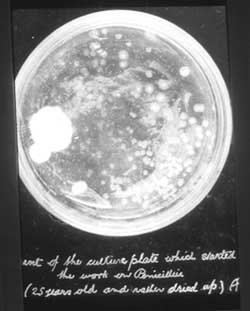THE
DISCOVERY OF PENICILLIN
There is much myth that surrounds
the story of the discovery of penicillin.
Flemings Fluff, which drifted in through a window near Paddington
station,
belongs, with Archimedes interrupted bath,
Newtons
apple
and James Watts kettle-on-the-hob, to the great scientific legends.
The Life
Savers by Ritchie Calder
The popular
story goes that Alexander Fleming was
carrying out an experiment on bacteria and when he left for the weekend a
technician left a window open and by some chance a spore drifted in and
contaminated one of his pertri dishes, when he came back a mold had grown and
was destroying a colony of staphylococci. In fact this couldnt of happened
due to the fact that the labs windows where shut permanently. In fact Fleming
had prepared a colony of staphylococci for research and went on a few days leave
when he returned one of the covers had shifted and the mold had grown. Fleming
was interested in his discovery and published the results, the report was not
met by much interest and in fact Fleming did not understand what he had
discovered and was not able to isolate the material due to its high reactivity.
 Fleming's
original petri dish
Fleming's
original petri dish
Its was only by luck that the research into penicillin was taken up
again. In the 1930s a research group at Oxford University lead by Howard
Florey and Ernst Chain began to
investigate the properties of naturally occurring antibacterial substances. As
there research developed they picked up on Flemings discovery, with a $5000
dollar grant from the Rockefeller Foundation they began to try and isolate the
active ingredient. Using a method known as freeze-drying not available in
Flemings time they were able to obtain a product a million times more potent
than Flemings crude material. By 1939 they were treating infections in mice
and by 1942 the product had been successfully tested on humans. Research by
Coghill in America enabled penicillin to be produced a wide scale and by 1944 it
was being produced on a wide scale for civilian use.
 Fleming's
original petri dish
Fleming's
original petri dish Fleming's
original petri dish
Fleming's
original petri dish